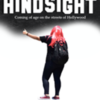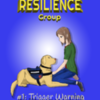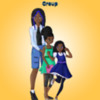When I first learned about Adverse Childhood Experiences during my intern year of Family Medicine residency training, it was like a switch had been turned on. My ACE score was high. 9. I poured through the literature, hoping for a way to “heal myself.” I was a healer, after all. And I hadn’t done much intentional work around healing from my incredibly traumatic childhood.
As I progressed in my training, the evidence mounted that my background made me different, at the same time that pioneers furthered our understanding of Resilience and the protective factors that can help save a traumatized childhood. But when I looked at the Resilience checklist, I didn’t find enough evidence that could explain why I made it. What helped me survive? I wasn’t sure. I couldn’t immediately conjure up any happy childhood memories or names of people that supported me as I struggled. I couldn’t figure out why I’d been able to beat the odds.
It was after I completed my residency training that I was finally forced to face my difficult upbringing. Five days after I completed my training and became a fully licensed, board certified physician, my oldest brother died by suicide. My beloved brother; the person who understood me better than anyone else in my broken family. For many years, he was the one who drew me back and convinced me to maintain contact with my family.
The aftermath of his loss taught me that I didn’t experience my traumatic childhood alone. There were five of us who grew up in a tumultuous childhood; while only two of us ended up in foster care, that didn’t mean that the others were spared. There were the ones who left, and the ones who stayed.
As I started my path towards healing, I started to write my story. I dissected the path that led me far from my childhood home to California, and carefully pulled all the most painful memories into a book. I poured my heart and soul into my words, and something amazing happened. First, I was finally able to tell my story of surviving teen homelessness and finding my way in the world. But more importantly, I learned something I didn’t fully understand. At almost forty years old, I finally allowed myself the one thing I’d been holding back since I’d been a teen: forgiveness.
All along, I knew I’d made poor choices as a teen, and I’d suffered the consequences in unimaginable ways. But I’d bought into the narrative that my family continued to share, time and again. I had believed that I was a “bad teen” and I’d brought all that pain and hardship on myself. I felt unworthy of love and didn’t ask for much from anyone. And that changed when I finished writing my story and shared it amongst my peers. It’s been widely accepted among the physician groups that I’m part of, and I’ve received countless private and public comments about how the book has helped physicians “see” teens in crisis and start to understand the depths of childhood trauma.
I’d like to share that story with the ACES community. My memoir, Hindsight: Coming of age on the streets of Hollywood, tells how a broken, traumatized girl found her voice. It shows how I unraveled and how I pulled it all together again, in a raw, deeply emotional way. I’m hoping that this story can help reach other youth in crisis and give them hope. As I realized when I wrote the story, there were a few amazing adults who found a way to break down my walls and reach me, even when I thought I was unreachable.
And after I finished Hindsight, the floodgates opened. I began my childhood trauma and resilience fictional series, geared towards middle school students ages 10 and up. The first two books have been released already, and there are many more to come. I'm hoping to encourage kids who are going through little and big traumas that they can hope, dream, and become who they are meant to be. I'm also making sure to include positive adults who are savvy about resilience and aim to help guide these kids towards healthier, safer lives. Link to Book 1 & Book 2.
Thank you.
Sheryl Recinos, MD






Comments (1)